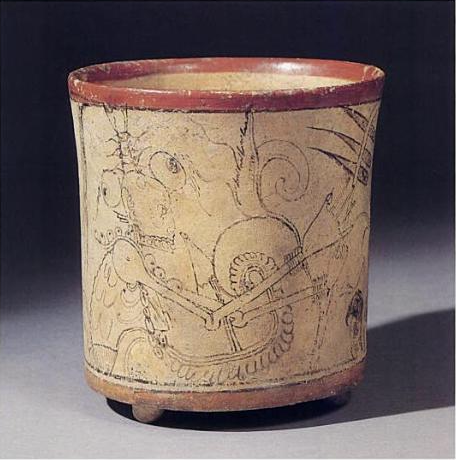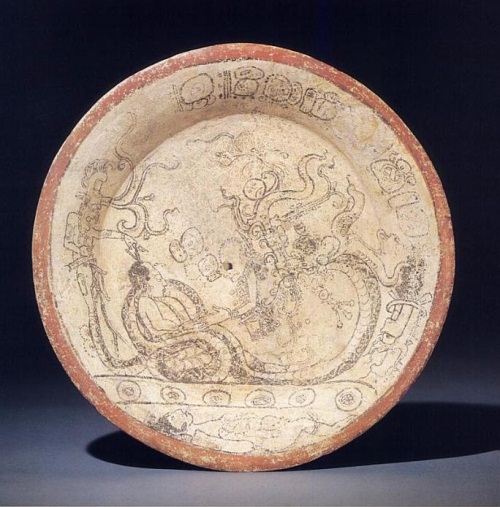The culture of Maya civilization remains one of the biggest questions of the modern scientific world. Having been developed in cultural and scientific spheres, Maya civilization was destroyed and did not remain till our time, except some materials evidences of its existence, sculptures, buildings, paintings, and ceramics. Considering Maya art, the themes of it were investigated, and it is notable that the biggest part of Maya tradition is devoted to Underworld, sacrifice, death and other depressing themes, which are not usual in our modern world.

Before starting the analysis of the chosen works of art, it should be mentioned that there are three main periods in Maya culture, the Preclassic period, which comprises 2000 BC – AD 250, then it came the Classic period AD 250 – 909, and the Postclassic period AD 909-1697. The works of art, which are going to be discussed in the current paper, belong to the classic period of Maya civilization. 600 AD is considered to be the breaking period in Maya’s life, and modern scholars identify the Early Classic Period, which is finished in 600 AD and the Late Classic period starts. During the Late Classic period the culture of Maya civilization “reached its peak population, greatest social complexity and artistic and intellectual highpoint” (Martin and Grube 9). These are the reasons, why this definite period was chosen as the point of investigation.
The first work of Maya art, which is going to be investigated, is codex-style vase with death god and bearded dragon. The vase is of cylindrical form, 12.8 cm high polychrome earthenware, which was created in Guatemala, El Petén, in the Late Classic period. The colors of the vase are cream, the biggest part of it, red, the top and bottom fringes, and black, the very picture of the vase. The picture on the vase shows the Lord of Death and Bearded Dragon. The vase has come to us in rather good condition, with slights grazes and cracks. The main theme, which is introduced on the vase, is death and sacrifice, when the Lord of Death sacrifices his life and is beaten by the dragon. The Lord revives then and the life cycle begins from the very beginning. This life cycle is the main theme which depicts the vase, to the point, such underground mythological themes were the main themes, which were used by Mayas in their art during the discussed period (Parsons et al 94).
The other work of art under analysis is codex-style plate with kill hole.

The work of art was also created in the Late Classic period, 600-900 AD, in Guatemala, El Petén. The diameter of the earthenware pale is 31.7 cm, and the picture of it is introduced in cream color, which is the basic for the piece of art, with red fringe and the picture is made in brown color (Parsons et al 96). The picture on the ale also introduces the legend, which is connected with death. The Old God and K God have come into a battle on the grave of a girl. The same theme is introduced on the plate, which was discussed in the previous example, the theme of death, underworld and sacrifice.
The theme of underworld is the main theme, which was developed through art of Late Classic period of Mayas. The life cycles, which are introduced on the works of art, are the Mayas’ beliefs in the rebirth of people, in the cases, when they sacrifice their lives. “The perpetual cycles contributed to Maya beliefs that death leads to rebirth and that renewal follows sacrifice; they shaped the Maya view of world order and underlay Maya rituals of bloodletting ad human sacrifice” (Foster and Mathews 92). The reasons for such beliefs were that Mayas’ believed in multiple souls of people and the question of death has never been the sorrow for them in a huge extend as they were sure in people’s reincarnation and that their life will be continued after revival. But still there were some cases, when people did not revive, and in such cases they appeared in the Underworld, Xibalba. The journey to this Xibalba rather difficult, and it should be mentioned that Maya kings considered this journey as their duty.
In conclusion, Maya culture is rather various and significant, it played the core ole in the development of some other cultures. Considering Maya art, the themes of it were investigated, and it is notable that the biggest part of Maya tradition is devoted to Underworld, sacrifice, death and other depressing themes, which are not usual in our modern world. The most developed part of Maya civilization’s culture is the Classic period, when it raised its highest spots. The examples of ceramics, which were discussed above, introduced one of the main themes, which all pieces of art were devoted in that period. The themes of sacrifice and death, the Underworld was deeply analyzed by Maya’s artists and introduced on different works of art.
Works Cited
Martin, Simon and Nikolai Grube. Chronicle of the Maya Kings and Queens: Deciphering the Dynasties of the Ancient Maya. London: Thames & Hudson, 2001.
Parsons, Lee Allen, Carlson, John B., Joralemon, Peter David, Kerr, Justin, and Indianapolis Museum of Art. The Face of Ancient America: The Wally and Brenda Zollman Collection of Precolumbian Art, Bloomington: Indiana University Press, 2001.
Foster, Lynn V. and Peter Mathews. Handbook to life in the ancient Maya world. Oxford: Oxford University Press US, 2005